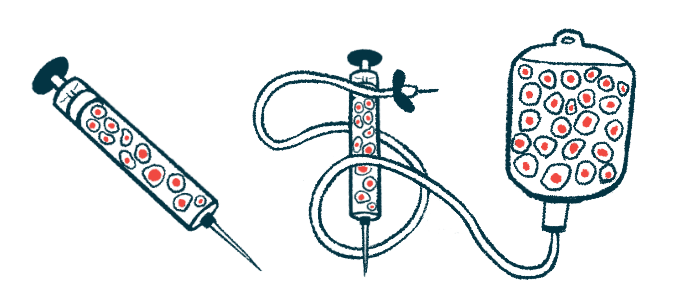Stem cell therapy found safe, effective in RRMS study
Most patients saw improvements after transplant, researchers in Sweden say

Nearly three-quarters of people with relapsing-remitting multiple sclerosis (RRMS) showed no signs of disease activity five years after receiving a stem cell transplant, according to a recent Swedish study.
Moreover, about half of patients with at least minimal disability saw improvements after the transplant and about one-third remained stable. While the procedure was associated with some serious side effects, the treatment was generally deemed safe, with no treatment-related deaths.
“This procedure should be considered a standard of care for patients with highly active RRMS,” the researchers wrote.
The study, “Haematopoietic stem cell transplantation for treatment of relapsing-remitting multiple sclerosis in Sweden: an observational cohort study,” was published in the Journal of Neurology, Neurosurgery, & Psychiatry.
Autologous hematopoietic stem cell transplant (aHSCT), commonly known as stem cell therapy or stem cell transplant, is a procedure aimed at resetting a person’s immune system to reduce the excess inflammation that contributes to autoimmune diseases like multiple sclerosis (MS).
Briefly, the procedure involves collecting a person’s own hematopoietic stem cells — those that give rise to mature blood cells — and infusing them back into the patient after a round of chemotherapy to wipe out existing cells and make room for new ones.
For MS patients, it’s thought this approach may help to repopulate the immune system with healthy immune cells that are not primed to attack the brain and spinal cord. Indeed, a growing body of evidence suggests that aHSCT could ease disease activity and disability progression for RRMS patients, particularly those with highly active disease.
The invasive procedure has been used for decades to treat MS patients, but it does not have regulatory clearance in the U.S. Concerns surrounding its use are related to a lack of well-controlled clinical studies to evaluate its efficacy, particularly in light of potential safety issues and its high cost.
aHSCT was approved by health authorities in Sweden in 2016. It currently is indicated for patients with active disease despite treatment with at least one disease-modifying therapy (DMT) or with rapidly evolving and severe disease.
Assessing the safety and efficacy of aHSCT in RRMS
In this study, scientists aimed to assess the safety and efficacy of aHSCT when used in RRMS patients as part of real-world routine medical case. Their study involved 174 RRMS patients who underwent the procedure in Sweden between 2004 and 2020.
Clinical outcomes were obtained from the Swedish MS registry, with patients having a median follow-up of 5.5 years post-transplant. Safety data was assessed using electronic medical records covering the 100 days after transplant.
Patients’ mean age at the time of the transplant was 31, and 64% were women. They had been living with MS for 3.4 years at the time of aHSCT and had received a median of two previous DMTs.
A total of 20 patients (11%) required treatment with a DMT after the transplant, with a median of 2.9 years between treatments. Also, 10 patients transitioned from RRMS to secondary progressive MS a median of 4.1 years after the transplant.
Results showed that 73% of patients showed no evidence of disease activity (NEDA) at five years post-transplant and 65% still maintained NEDA status at 10 years. NEDA is defined as the complete absence of new relapses, new or enlarged MRI lesions, and confirmed disability worsening.
Relapses reduced significantly
The average number of relapses per year was significantly reduced after the transplant, with patients having a mean of 1.7 relapses per year before the procedure compared with 0.035 relapses per year during the follow-up period.
Before receiving aHSCT, a total of 149 patients had at least minimal disability, defined as a score of 2 or higher on the Expanded Disability Status Scale (EDSS). Of them, 80 (54%) experienced a confirmed disability improvement, 55 (37%) were stable, and 14 (9%) experienced disability worsening.
The proportion of patients experiencing no disability, or EDSS scores of 0-1.5, increased from 13.3% at baseline to 45.1% three years post-aHSCT.
The treatment was generally considered safe. While serious side effects were reported, all of them “could be managed using standard procedures at a … hospital,” the team noted.
Febrile neutropenia was a side effect
Febrile neutropenia, or low blood counts of immune neutrophils accompanied by fever, was the most common side effect linked to the procedure, observed in 72% of patients.
Chemotherapy and aHSCT are associated with immune depletion, meaning the procedure can increase the risk of infections. Overall, 61 people (35%) developed a bacterial infection within 100 days of treatment, 23 people developed viral infections, and three people had a fungal infection.
Five people required admission to intensive care, but there were no treatment-related deaths.
Overall, “our findings demonstrate that aHSCT for RRMS is feasible within regular healthcare and can be performed without compromising safety,” the researchers wrote.
While the study is limited by its observational nature, the scientists noted that the disability-related findings were similar to those reported in a randomized-controlled clinical trial of aHSCT (NCT00273364).
“We believe that aHSCT could benefit a greater number of MS patients and should be included as a standard of care for highly active MS,” the team concluded.







